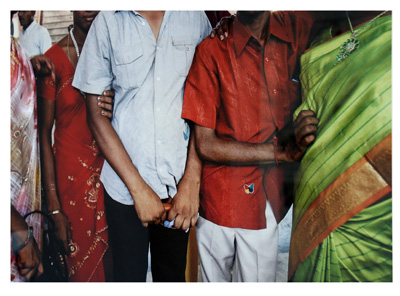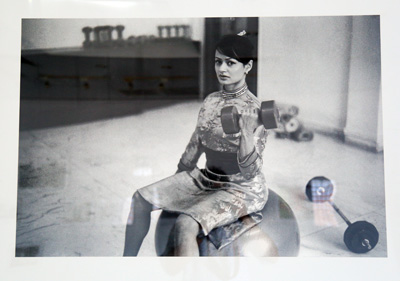13 artists exhibit at ‘Embody: the Gender Issue’
 The walk through the Harold Peiris Gallery was heady. It felt as if the photos on the walls were bursting to break out of their frames. They challenged all norms and traditional conceptions of gender; and they stimulated, thrilled and exhilarated.
The walk through the Harold Peiris Gallery was heady. It felt as if the photos on the walls were bursting to break out of their frames. They challenged all norms and traditional conceptions of gender; and they stimulated, thrilled and exhilarated.
Titled Embody: the Gender Issue, the exhibition featured 13 photographers; or more properly, artists. It was the first in a line-up of events for the 2015 Colombo Pride to be held throughout July. The exhibition was not strictly LGBTQ, but transgenderism got the lion’s share of attention.
The photographic depictions of the Aravanis and the Hijras of India were the most interesting. Photographer Tejal Shah’s series of photos titled Hijra Fantasies were Technicolor, dream-like, stylised and beautiful. One shows a hijra poised as Yashoda, pointing out a moon in a blue sky to young Krishna. Another depicts a hijra dancing with a handsome man in all the gaudy splendour of a Hindi film. A highly erotic image of a hijra with an all but nude young man follows. The photographer has managed to capture the longings of this so-called “Third Sex”- longings all the more powerful because forbidden.
Then there were the everyday, or real-life, Hijras and Arvanis. Dressed in sarees but the stamp of masculinity still obvious on their faces, they seem happy to be of a gender of their own. Not that the real women were neglected: Aishwarya Arumbakkam celebrates them in her work which places photos of ‘item girls’, glamorous beauties of Bollywood, alongside photos of ordinary women dressed to resemble them. She has managed to capture the difference between the women on stage against the imperfection of day-to-day women. Some of these latter have bloated midriffs; others are plump and little; yet all are more authentic when compared with the film stars.
 Nick Oza’s series of photos document how Jamie Roberts changed from man to woman. It shows the arduous, gruelling journey, of surgery and pain, in between the “Before” and “After” photos of transwomen, which often hide the hard reality.
Nick Oza’s series of photos document how Jamie Roberts changed from man to woman. It shows the arduous, gruelling journey, of surgery and pain, in between the “Before” and “After” photos of transwomen, which often hide the hard reality.
Indu Antony’s photos were of drag kings: women parading their inner masculinity dressed as pastors, policemen, bandits, Superman, and Michael Jackson. Not being transgendered but merely flirting with masculinity, these depictions verged on the comic.
Sachini Perera and Natalie Soysa, two Sri Lankan photographers, used projects of newspaper clippings on the nude bodies of women to show how women in Sri Lanka “strive to find a balance between archaic societal norms and their own inherent identities as equal citizens within the country.”
As a final verdict, I would say the exhibition shatters the two-dimensional and the traditional to reveal a thousand shades and a thousand shapes, which rival even the “rainbow”.


